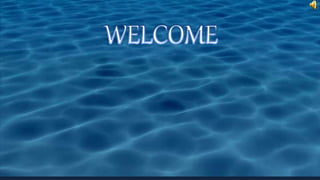
fishy culture Bio ppt1.1
- 5. Hey, Fisherman!Hey, Gentleman!How was you, my friend? I am fine! Thankyou! What do you know about, “Fishing”? Okay! I gonna tell you about, “Fishing”? Let’s go ahead!
- 6. Fish Farming Capture & Culture Fishing Marine Fisheries Mariculture Inland Fisheries Composite Fish farming Quality Fish Seed
- 7. • Fish is a cheap source of animalprotein.
- 8. • Enclosures like tanks are used to produce fish for commercial purposes, called fish farming.
- 9. Catla Rohu
- 10. Prawn Molluscs
- 11. Capture Fishing Culture Fishing
- 12. • Capture Fishing: Capture fishing involves obtaining fish from natural resources. Like in sea water or fresh water. • Culture Fishing: Culture fishing involves culturing the fish in small enclosures.
- 13. Fishing Marine Fishery Inland Fishery
- 14. • Fishing in saltwater regions is called Marine Fisheries. • Mariculture involves culturing of fish in marine water. • Marine fishery resources include 7,500 KM of the Indian Coastline.
- 16. • Fishes harvested from saltwater regions.
- 17. • Mariculture involves culturing of fish in marine water. • Mariculture is a specialized branch of aquaculture involving the cultivation of marine organisms for food and other products in the open ocean, an enclosed section of the ocean.
- 19. • Inland fisheries comprise fresh water & sea water where fish are trapped or captured. • Fresh water resources include canals, ponds, reservoirs & rivers. • Sea water resources include oceans. • There is an overlap between bodies of water classified as coastal and bodies of water classified as estuaries. lagoons
- 22. • The Composite fish farming system is a technology developed in India by the Indian Council of Agricultural Research in the 1970s. • In this system both local and imported fish species, a combination of five or six fish species is used in a single fish pond. • These species are selected so that they do not compete for food among them having different types of food habitats. • As a result the food available in all the parts of the pond is used. • Fish used in this system include catla and silver carp which are surface feeders, rohu a column feeder and mrigal and common carp which are bottom feeders. • Other fish will also feed on the excreta of the common carp and this helps contribute to the efficiency of the system which in optimal conditions will produce 3000–6000 kg of fish per hectare per year.
- 23. Grass Carp Catlas Rohus Common Carp Mrigal Surface Feeders Middle-Zone Feeders Bottom Feeders Weed Feeders
- 24. • These fishes can use all the foodin the pond without fightingwith each other. • This increases the fish yieldfrom the pond.
- 25. • In intensive culture systems there is a decreased dependence on the availability of natural food and greater dependency on the use of commercial feeds. • Densities of fish kept within such holding areas are limited by species tolerance, ability to grow at raised stocking densities and maintenance of environmental parameters rather than the production of a natural food supply.
- 26. • Extensive aquaculture is the other form of fish farming. • Extensive aquaculture is more basic than intensive aquaculture in that less effort is put into the husbandry of the fish. • Extensive aquaculture is done in the ocean, natural and man-made lakes, bays, rivers, and Fiords. • Fish are contained within these habitats by multiple mesh enclosures which also function as trapping nets during harvest.
- 27. • One problem with such composite fish culture is that many of these fish breed only during monsoon. • Even if fish seed is collected from the wild, it can be mixed with that of other species as well. So, a major problem in fish farming is the lack of availability of good- quality seed. • To overcome this problem, ways have now been worked out to breed these fish in ponds using hormonal stimulation. • Fishes are now injected with hormones that stimulate the production of eggs or seeds. • This has ensured the supply of pure fish seed in desired quantities.
